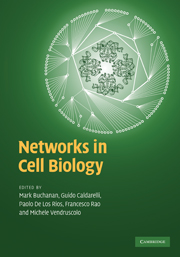Book contents
- Frontmatter
- Contents
- List of contributors
- Introduction
- 1 Network views of the cell
- 2 Transcriptional regulatory networks
- 3 Transcription factors and gene regulatory networks
- 4 Experimental methods for protein interaction identification
- 5 Modeling protein interaction networks
- 6 Dynamics and evolution of metabolic networks
- 7 Hierarchical modularity in biological networks: the case of metabolic networks
- 8 Signalling networks
- Appendix A Complex networks: from local to global properties
- Appendix B Modelling the local structure of networks
- Appendix C Higher-order topological properties
- Appendix D Elementary mathematical concepts
- References
- Index
Introduction
Published online by Cambridge University Press: 05 June 2012
- Frontmatter
- Contents
- List of contributors
- Introduction
- 1 Network views of the cell
- 2 Transcriptional regulatory networks
- 3 Transcription factors and gene regulatory networks
- 4 Experimental methods for protein interaction identification
- 5 Modeling protein interaction networks
- 6 Dynamics and evolution of metabolic networks
- 7 Hierarchical modularity in biological networks: the case of metabolic networks
- 8 Signalling networks
- Appendix A Complex networks: from local to global properties
- Appendix B Modelling the local structure of networks
- Appendix C Higher-order topological properties
- Appendix D Elementary mathematical concepts
- References
- Index
Summary
Biologists now have access to a virtually complete map of all the genes in the human genome, and in the genomes of many other species. They are aggressively assembling a similarly detailed knowledge of the proteome, the full collection of proteins encoded by those genes, and the transcriptome, the diverse set of mRNA molecules that serve as templates for protein manufacture. We increasingly know the “parts list” of molecular biology. Yet we still lack a deep understanding of how all these parts work together to support the complex and coherent activity of the living cell; how cells and organisms manage the concurrent tasks of production and re-production, signalling and regulation, in fluctuating and often hostile environments.
Building a more holistic understanding of cell biology is the aim of the new discipline of systems biology, which views the living cell as a network of interacting processes and gives concrete form to the vision of François Jacob, one of the pioneers in the study of genetic regulatory mechanisms, who spoke in the 1960s of the “logic of life.” Put simply, systems biologists regard the cell as a vastly complex biological “circuit board,” which orchestrates diverse components and modules to achieve robust, reliable and predictable operation. Systems biology suggests that the mechanisms of cell biology can be related to the information sciences, to ideas about information flow and processing in de-centralized networks.
This view, of course, has long been implicit in the study of cell signalling and other key pathways of molecular bio-chemistry.
- Type
- Chapter
- Information
- Networks in Cell Biology , pp. 1 - 3Publisher: Cambridge University PressPrint publication year: 2010



